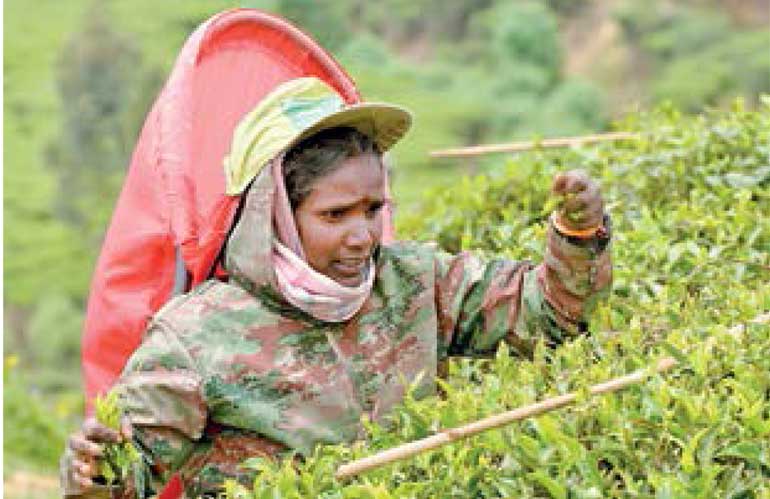Friday Dec 26, 2025
Friday Dec 26, 2025
Monday, 6 February 2017 00:00 - - {{hitsCtrl.values.hits}}

‘Low External Input Sustainable Agriculture’ (LEISA) is receiving increased attention, both as a sustainable alternative to green revolution-like strategies making intensive use of external inputs, and as a strategy of sustainable agriculture in resource-poor environments where no or very few external inputs are used.
Reading views expressed by some eminent personnel in the tea industry, it is quite apparent that the allegation is that the country’s tea industry is likely to be worsened with the ban of the herbicide glyphosate. But the relevance of this notion has to be viewed alongside with what is going on in the global sphere instead of looking at it from a very narrow focus.
While acknowledging that there are other issues that may qualify to be on the top of the list and the objective here is to point out the obvious and start a discussion so that the policy makers in Regional Plantation Companies (RPCs) would hopefully listen.
The glyphosate debate
It is still a debate whether glyphosate should be allowed or totally banned from tea plantations. It is important to realise the difficulties in practicing fully organic practices. Hence, a long-term succession approach is needed.
I am no way proposing or promoting a ban of chemical weeding but trying to point out that with the overuse of chemicals the harvest will be affected in the long run and prices may drop. I do not think that this is new information.
High cost of production and low productivity was there even before the ban as well but then what have they done to tackle it? Very little from a strategic point of view. That clearly shows the impotency and lack of management will to turn things around. They knew every once in two years the wage increase was coming but they were not prepared to face the issue. All we collectively agree on with or without statistics is that we have an industry-threatening issue that has no solutions internally at the moment.
I am not a scientist and also do not wish to be controversial and my personal experience and view is that continuous use of a single herbicide frequently might carry a risk of a build-up of resistant species which may be harmful. Risk is a part and parcel of any agriculture and it has always been there and will never go away. It is therefore very important that planters to have the capacity to understand, face and over ome this aspect.
An article published in January, 2017 in Scientific Reports 7, Article number: 39328 under the title of ‘Multiomics’ reveals non-alcoholic fatty liver disease in rats following chronic exposure to an ultra-low dose of roundup herbicide. It would be ideal if any individual or any association can prove that the research findings are wrong rather than making silly statements showing their petty-minded narrow thinking, thus throwing thousands of human lives in added danger.
Most genuine planters who are patriotic but voiceless join with me in saluting the PM and Minister Navin Dissanayake for unmasking these top guns who are still tolerated by their masters for reasons best known to them. But their days are numbered as an eminent team of less than 20 genuine planters headed by Jeevaka Atapattu are heavily involved in unearthing the bitter truth of destruction of Regional Plantation Companies.
No time for procrastination
Whilst acknowledging genuine interventions of the team behind him as well, let me be very open that what is needed at this eleventh hour is not more commissions in the pretext of psychological torture. Both PA CPS and all other leading trade unions must put their best foot forward and link up with the team headed by Atapattu and come out with the plan of damage control leading to another golden era of smart plantations.
There is no time for procrastination. The Minister with the blessings of both the President and PM must develop the second line of defence. NIPM, IPM, ICA and PIM must be summoned to come out with a strategic plan for the entire industry with identified smart goals for each year.
As long as there are intelligent inputs, many investors will look at the plantations industry as a golden opportunity. Only the insane will be attracted if we are looking at doing the same thing over and over again expecting better results.
The industry must understand the value of HRM inputs even at this late stage before it becomes too late and reaches a state of irreversible damage. All must understand that the clock is ticking.
Spraying and weeding
Coming back to the story of glyphosate, it was used in the past in extremely small proportions to eradicate the infestation of tea fields with couch and illuk, which are generally in ravings, roadsides and boundaries.
If I am not mistaken glyphosate was introduced in the early 1980s under a World Bank project to use glyphosate to recondition fields with grass prior to re-planting, especially to control couch in badly infested fields uprooted for re-planting.
According to Tea Research Institute instructions (in the 1980s) it is important that high-yielding fields have to be kept free of couch and glyphosate to be sprayed in fields, provided the sprayed patches are left without being plucked for a period of at least three months after spraying.
The TRI from time to time recommended using various other herbicides as well taking into consideration the herbicide to be used depending on the weed species present at the time of the application and taking into account the retail price. TRI has imposed a two round spray limit annually to minimise the risk.
Weeding is an unproductive exercise. There are advantages as well as disadvantages on spraying because sometimes the side branches and the plucking table may get damaged and thereby the yields will go down and the other hand it keeps the cost down. Therefore it has to be undertaken very carefully.
Those days we had a very effective manual and chemical weeding program. Once we sprayed a herbicide (not glyphosate) after one or two months later we would do a kyporuku (removing weeds by hand) in order to remove the resistant weeds such as Amalay and Alavangupillu and bring them to the roadside and heap it.
The weeding program and its cost has to be decided by the management in the estate taking into consideration various aspects such as the VP and seedling percentages or the hectarage division wise and sometimes you may have to give a little extra money for some opened fields where there are more vacant patches (pottals) which not rehabilitated (planted with grass), if not the field staff will cross charge the weeding workers on some other items specially on plucking and cover this cost from well-covered VP fields. This has to be within the budget given by managing agent. We accordingly handled the weeding cost and never allowed the fields to get overrun with weeds except for the fields that were due for uprooting for re-planting.
It might not be possible to develop a chemical weeding program for all plantations in the short run. Therefore, the chemical weeding program needs to be developed at estate level. This might look like an overwhelming task but it could be turned into a productive investment.
There has to be a control on using too much chemicals in the plantations. The monitoring has to be done by a reliable authority and I propose a Government authority with all the powers to take decisions on estates’ overuse of chemicals to be appointed.
Over the years chemical weeding has become an integral part of plantations but now it is now increasing.
High cost and low productivity
If you go back to history, normally over a period after pruning, there will be a certain percentage of nearly 10% of die back, maybe due to shot-hole-borer,  mites, etc., and what we did was remove those bushes and plant the rehabilitation grass in those patches and resupply with VP plants later. It was called infilling. I do not know whether it has been carried out, but if it had been done there should have been a crop increase over the years.
mites, etc., and what we did was remove those bushes and plant the rehabilitation grass in those patches and resupply with VP plants later. It was called infilling. I do not know whether it has been carried out, but if it had been done there should have been a crop increase over the years.
However, the million dollar question is whether Sri Lanka or the industry has benefitted from privatising the country’s biggest asset? The RPCs have access to better management and how far have they been successful in value addition except for a few RPCs which have to be commended for their initiative in the right direction?
It should be noted with concern that by statute 3% of the total tea lands should be re-planted with VP each year and anyone is well advised to check whether it has happened and if so present success percentage. Ex-planters who were in service prior to the nationalisation in 1975 will remember how they had to forward the annual return to the PA each year indicating the acreages re-planted.
It is appropriate if the officials of the Plantation Restructuring Unit attached to the Financial Ministry explain whether in the 22 management contracts drafted by them the minimum requirement or compulsion to re-plant tea/rubber is there in the management contracts signed by the RPCs or if they drafted the management contracts to look after the interest of the citizens or for the benefit of the RPCs.
The civic-minded public is very concerned about the present state of some of the privatised plantations. We must focus on soil rehabilitation and safe drinking water as well as Sri Lanka’s ailing plantation industry in general and the tea sector in particular needs urgent intervention in order to make the industry a $ 10 billion industry by 2020.